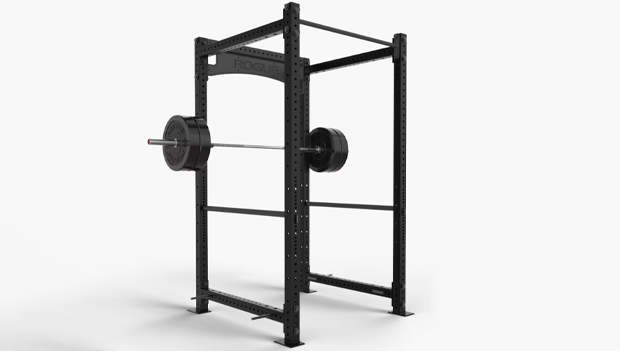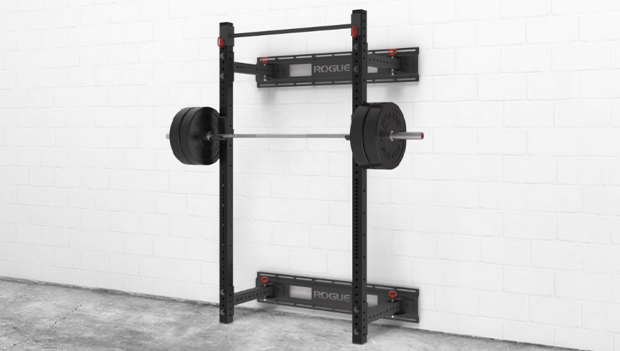
If you want a reliable and dependable workout space in your home, then one item that you simply must have is a squat rack. Besides the namesake exercise itself, the barbell squat, a squat rack can help you perform other movements such as the bench press, shoulder press, and partial deadlift. Some may even have storage sleeves, which would allow you to use your weight racks in another part of the room. You should be able to load your weight plates on the barbell and use the rack without interference on either side. Clearance, while you're training inside or outside of the rack, is also very important.
If you're looking for a rack already, then your biggest debate may be the full rack versus half rack. If you're a beginner or aren't familiar with home gym fitness equipment, you may not even be sure what those terms mean. Fortunately, the ACTIVE Reviews Team wants to help educate you so you can be best prepared to not only develop your home gym, but invest in the best products possible so you can have the best training sessions now and later. You can read on to find out more about the important differences between these two types of squat racks, then determine which of our recommended picks would be the best one for you and your workout goals.
Why Trust Us?
ACTIVE.com's editorial team relies on the knowledge and experience of fitness and wellness experts including competitive athletes, coaches, physical therapists, nutritionists, and certified trainers. This helps us ensure the products we feature are of the highest standard. Collectively, the team has spent countless hours researching equipment, gear, and recovery tools in order to create the most accurate, authentic content for our readers. Customer satisfaction is also a key part of our review process, which is why we only feature products that are highly rated.
Full Rack vs. Half Rack
By clicking on the product links in this article, we may receive a commission fee at no cost to you, the reader. Sponsorships and affiliate commissions help support our research so we can help you find the best products. Read the full affiliate disclosure here.
Full Rack
Half Rack
What Is a Full Rack?

You may have heard this type of rack called a "power rack," and some lifters even call it a "cage," representing the four corners that the lifter stands in the middle of. A full rack is a four-cornered square or rectangle-shaped rack with four uprights that are all connected at the top for additional stability. It's the four corners that make it a "full" rack. The safety arms connect on both sides, making it a dependable support for the weight that you intend to use. If you were to drop a barbell on the safety arms, then the ends of those arms would be better equipped to support that weight instead of arms that are only connected on one side.
You can use the safety arms as starting points for some exercises, like bent-over barbell rows, as well as to rely on if you reach failure before the end of a set. The weight shouldn't be slammed or dropped on purpose, but sometimes it may not be avoidable, and you want the most support possible. Some racks also have pull-up bars at the top, adding another exercise to the workout repertoire. Other racks may even have the capability of adding attachments such as a lat pull-down station.
What We Like About Full Racks
Full racks are considered the safer and stronger version of the two types of squat racks, which makes them a better option for lifters and fitness enthusiasts who consider strength a priority. They also add more versatility to the programs you may be interested in doing because they offer more exercise options. They are also sturdy and have higher quality racks, which make them a better long-term purchase. Beginners would be well-served by purchasing a full rack.
You can perform lying and seated exercises in the full rack if you have an adjustable bench that you can place in the middle of the rack. The safety arms also serve as spotters if you train alone. You should never train super heavy without someone to assist you, but you can push yourself to perform a couple of extra reps in a full rack without fear of being stuck if you set up the safety arms correctly.
What We Don't Like About Full Racks
There are a few downsides to having a full rack. First and foremost, they do cost more money than a half rack because they require more material and they are heavier. They are also harder to take care of because of the wear and tear that training with them on a regular basis can cause.
Secondly, they require more space than a half-rack, and they will impact the rest of your training space. If a full rack has weight sleeves for storage, band pegs, and other attachments, then they will need even more space around them. Some racks are also taller, which means you would need to have the ceiling clearance to make it fit.
Our Recommended Full Racks
What Is a Half Rack?

The full rack has four uprights, so a half rack is a station that has only two uprights. A half rack still has a connecting bar at the top, and it has holes for you to place J-hooks and safety arms. However, those safety arms are not connected on the opposite end in which they are connected to the rack. They will still support significant weight, but they may not be as stable as a full rack unless the half rack can be bolted to the ground.
The half rack may not be as wide or as long as a full rack. They could be shorter, as well. The connecting bar can sometimes double as a pull-up bar, but these types of racks won't have as many attachments or connecting points as a full rack would.
What We Like About Half Racks
The half rack doesn't take up as much space as the full rack, so that gives you more freedom to choose how you train in your home gym. You can still position the safety arms so you can rest the barbell on them to start exercises such as the barbell shrug. If you have the height for other exercises such as the push press, then you can use the half rack for those because you don't have to worry about the top of the rack interfering with the lift as would be the case with the inside of a full rack. You can also use a bench inside of a half rack to perform movements like the incline bench press.
Secondly, they are easier on the budget. A half rack is less expensive to both purchase and ship. You can also perform other exercises outside of the rack such as the standing barbell press and the barbell curl. That flexibility can make your workouts more interesting and it could even help you train faster since there are fewer adjustments to make. There are some racks that secure to a wall and can be folded in so it is out of the way while you perform other exercises in your routine. Intermediate or advanced lifters who want a simple set-up could buy a half rack for their training needs.
What We Don't Like About Half Racks
Half racks aren't as strong as full racks, and in some cases, they are made out of different materials that may not support as much weight. Since you can't use as many attachments with a half rack, you may need to buy other products if you wish to have other training options. The safety arms also won't be as sturdy because they are only connected at one point each instead or two. Eventually, the weight resting on the arms will cause them to droop and bend at the anchor point in the rack.
Not all half racks come with support arms, either. That means you must have someone to train with so you can work out safely. Buying support arms in this case would also require another purchase. Furthermore, the rack itself is less stable. So, if it can't be bolted in the ground and you return the barbell to the rack with force, then the rack may become unbalanced and tip over, causing damage to the walls, weights, rack, and even possible injury to yourself as the lifter.
Our Recommended Half Racks
Full Rack vs. Half Rack: Which Is Better?
Which rack would be better for your home gym? The answer to that is very individualized because your training space and goals determine the solution to that question. If you have the capability of making a full rack work in your home gym, then getting the full rack would be the recommended move because of the improved safety factors. However, not everyone has the perfect setup or a large space for a home gym,
If you have limited training space, a tight budget to work with, and moving heavy weight isn't a major priority, then getting a half rack could be a sensible decision. Just make sure that the rack you choose can be secured, support a reasonable amount of weight, and you can make the most of the assets that come with it.
For example, a half rack with a pull-up bar at the top would be better than one that simply has a crossbar for support only. If the rack you purchase is capable of having additional accessories added such as dip attachments, band pegs, or a cable machine, then that is something you can invest even more into later on. The more you can do with the rack you choose, the better the investment it will be both now and well into the future. A quality rack made out of durable material can last you several years if it is taken care of properly.
FAQs About Full vs. Half Racks
What is the purpose of a half rack?
The purpose is to safely offer a way to perform more barbell exercises than those that start on the floor. A half rack is designed to offer home gym owners a way to perform various barbell exercises, such as the squat, in a safe way without committing a lot of space in the workout room. They are appealing to many lifters because they take up less space than a full rack. It's a more cost-effective product than a full rack because it requires fewer materials.
Is a half rack better than a full rack?
If you have a small home gym and you need to make the most out of the area you have, then a half rack would be a better option. You should get one that includes support arms so you can train safely with less chance of suffering an injury or getting stuck under a lot of weight on the bar.
A full rack would be better for lifters who want to train with heavy weights or insist on training alone. The extra uprights and connecting points of the safety arms allow more weight to be lifted, and the rack itself will be more stable and secure. Regardless of which type you feel is better for you, make sure you have the ceiling clearance before hitting the order button.
Do you have to bolt down a half rack or full rack?
Not all racks need to be bolted down, and some don't even have the option for that to happen. If the rack has weight storage for you to keep plates on, then the rack will be more likely to stay in place. The simple advice to follow when it comes to bolting down the rack is "use the benefits you're given." So, if it is capable of being bolted down, then you should do so to maximize personal safety.


